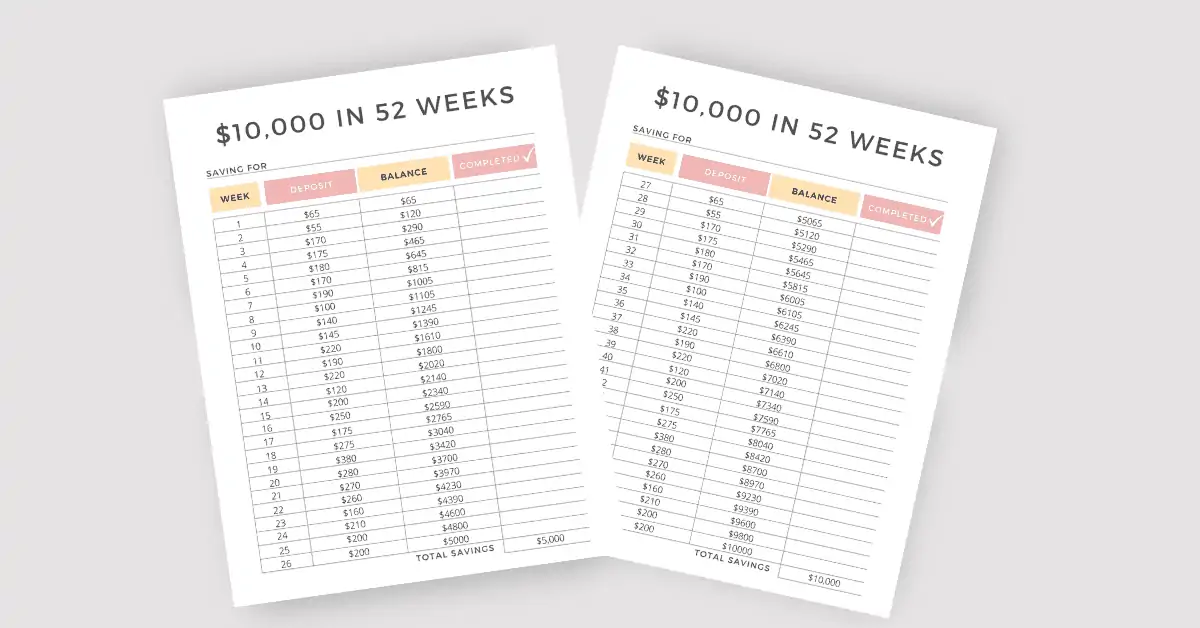*This post may contain affiliate links. Please read the full disclosure here.
If you’ve ever wondered how people save $10,000 in six months to a year – your answer is the 10k savings challenge.
The idea behind this is to save $10,000 in 52 weeks by saving a set amount of money each week.
You can certainly save $10,000 in just one year by making small, meaningful, changes to your financial lifestyle.
Start your savings journey by establishing your income then deciding on a budget for every expense such as rent/mortgage, bills, food, travel, and medical care.
Setting a savings goal as high as $10,000 in a year can seem daunting. But we’re here to help you make sense of your finances – from where the money is coming from to where it’s going, and how to keep yourself and your savings healthy and on track.
52 Week Money Challenge pdf
This 52 week money challenge pdf will help you reach your goal of saving $10,000 in a year. Each week you save a set amount of money from your income, savings or a side hustle.
You start slow, by saving under $200 each week in the first few weeks. Later on, you increase your savings by $250-$350 per week.
At the 26th week milestone – your halfway there and have saved $5,000. Now, you repeat the same process and save the same amount of money you saved in week 1-26.
Once you get into the habit of setting money aside to save, and you see your savings grow, its only a matter of time before you reach the end of the challenge.
Now the fun part – the 10k challenge. We are giving you an easy to use, free 52 week money challenge pdf.
Simply click this link for a straightforward download, that you are free to print and use. Once you have it printed and ready, check the boxes after completing each week of the 52 week money challenge.
For example in the first week you save $65. Once you have saved that amount, check the completed box.
In week 2, you save $55 and the total balance you saved from week one and week two is $120. Now check the completed box, and so on till you reach week 52 of this challenge.
Now, let’s move on to the important bit – ways in which you can earn and save $10,000 a year.
How to save $10,000 in a year
If you want to save $10,000 in a year, then it’s time to make some changes.
These changes may seem insignificant, but in the long term they will begin to add up and your savings account will thank you.
To begin working towards your goal you need to have a clear idea of how much money you earn and what you spend your money on – this allows you to take control of your finances.
Set limits on different expenses categories and committing to these strategies will help you reach your goal.
1. Start a monthly budget
Creating a monthly budget is one of the first steps you can take towards having control over your finances. It can help you identify where your money is going, work out any expenses that catch you by surprise, and cut out any unnecessary spending.
Here’s a quick guide to starting a budget:
1. Gather all your financial paperwork including bank statements, bills, tax documents, and receipts.
2. Establish how much money you are bringing in each month. Include your main source of income as well as any other money coming into your bank account.
3. List all your expenses. Include rent, food, bills, travel, medical care, and so on.
4. Dedicate a set amount of money to each of these expenses beginning with expenses that are out of your control, like rent. Split the money you have left among the expenses that you do have control over, like food.
5. Make adjustments so that your income is greater than your expenses. You can’t change your rent, but you can cut down on eating out. Hitting a savings goal is all about compromise.
That’s your first step to save $10,000 in a year – attention to detail!
2. Set aside and save money each month
A budget is more than limiting your spending, it also helps you define how much money you can afford to set aside.
Even if you just start with $5 per day in savings, by the end of the year you already have $1,825 in savings.
This plus all the other tips in this article will have you on your way to hitting your savings goal.
At the end of the month, check your budget.
Didn’t spend as much on food this month? Put it in savings.
Didn’t travel as much? Put it in savings.
Don’t be tempted to let these little bits of bonus money slide out of your hands – set them aside! Being strict with yourself is part of how to save $10,000 in a year.
3. Get rid of unwanted things
Is your house looking a little cluttered?
Are you surrounded by old hobbies you gave up or the gym equipment you don’t have time for? Then get selling!
There are plenty of marketplace-style websites available for you to shift any unwanted items and make some extra money. Consider setting up shop on sites like Amazon Marketplace, Facebook Marketplace, Craigslist, eBay, or even Depop.
Having a little extra cash coming in is how to save $10,000 in a year, just make sure you are putting that cash straight into your savings! Don’t be tempted to treat yourself with the extra pocket money.
4. Stop buying things you don’t need
This may seem like an obvious one – but it’s important stop buying things you don’t need.
Remember that $5 daily saved dollars? What if instead of setting that money aside every day you instead vow to not buy anything off budget?
You’ve made your budget, you’ve calculated your expenses, and now you know how much you can save by setting just a few dollars aside every day.
So why waste all that effort on something you probably don’t need? Cut the impulse spending, get tough with yourself – that’s how to save $10,000 in a year.
5. Cancel unwanted subscriptions
What with streaming services, music platforms, online content creators, workout programs, and newsletters it’s hardly surprising that we lose a huge chunk of our budget to forgotten subscriptions.
We’re not suggesting you cancel every subscription in the pursuit of savings.
But when was the last time you took an audit of all the things you pay for online?
While you are creating an expenses goal, don’t forget to look through your banking history for any standing orders and direct debits you may have forgotten about and cancel them before you lose any more money!
As well as the subscriptions you have forgotten, what about the ones you don’t really need anymore?
Cancelling a subscription counts towards your effort to get rid of unwanted possessions, only rather than making money you are saving it.
6. Reduce eating out
Eating out is expensive, and your restaurant habit is eating into your savings.
When you choose to eat out you are spending money on food you could make cheaper at home and running the risk of wasting food in the refrigerator.
Throwing away food that’s gone bad because you couldn’t resist a trip to your local eatery is a savings nightmare and it’s time to cut it out!
Here are some quick tips to reduce how often you eat out:
- Plan your meals and prepare the ingredients ahead of time. You’ll have something quick and easy to look forward to eating, perfect for lazy days when takeout seems like the easier option.
- Shake up your menus. Do you want to eat out because you are bored of your own cooking? Time to shake it up in the kitchen.
- Stock up on favorites. Look, we’re not all perfect, and sometimes all you really want is a big pizza and some fries. Luckily for the savvy-savers amongst us, pizza and fries can be bought frozen for less than half the cost of a takeout.
7. Start a side hustle
Side hustles have really taken the world by storm. They are a way to add some extra dollars to your bank account at the end of each month to grow your savings.
Side hustles can be anything you’d like them to be. You could pick up food delivery shifts, start freelance writing, monetize your social media skills, work as a dog walker, or drive for Uber.
If your main employment is supplying your expenses funds, then let your side hustle supply your savings funds.
The best thing about a side hustle is that you aren’t depending on it to live, so have some fun and find something that works for you and your savings goals!
8. Make a shopping list
Grocery shopping is a budget minefield.
It’s all too easy to go in there with the best of intentions and come out having blown your budget on overpriced items you didn’t even need.
Making a shopping list and actually sticking to it will help you limit and control your spending while supporting you with meal planning for the weeks ahead.
Decide what you need from the store, decide how much you need, and don’t be tempted to go overboard.
9. Use cashback apps
Cashback apps and coupon sites let you get a bit of your money back following a purchase at specific stores and online retailers and can give your finances a boost.
This cash is given back to you usually as coupons, discounts, redeemable tokens, or direct PayPal payments.
In the world of “a little bit, very often” these returns will eventually add up and can help you make savings in the future.
Just make sure you aren’t tempted to buy things you don’t need – cashback apps are your friend when it comes to grocery shopping and energy bill payments.
10. Meal plan
Meal planning is a saving superpower.
It helps you budget your grocery shopping, removes the motivation to order takeout, and reduces food waste, all of which add up to healthy expenses and flourishing savings.
To take your meal planning one step further, why not batch cook all your meals for the week and freeze them?
This way you’ll save yourself time in the long run and will be less tempted to go off plan. Who wants to go back to the grocery store when there’s a full meal waiting at home?
11. Have a “no spend challenge” month
Monthly challenges have been all the rage for a while now, and that includes no spend challenges.
When asking how to save $10,000 in a year it’s not easy to think of cutting back on all of life’s little luxuries. And with proper budgeting you won’t have to, but a no spend challenge is different.
Here, you can set yourself the challenge of not spending anything at all that isn’t included in your budget. So no spontaneous lattes, no trips to the movies, and no impulse buys at the store.
You’ll be amazed how much you manage to save in just one month of tighter spending control.
Don’t worry, this isn’t a sentence to a boring life! There are still plenty of ways you can have fun without spending money.
Plan for and cook your favorite meals, arrange a date night around the movies on TV, or go to free museums and parks for days out.
By the end of your “no spend challenge” not only will your $10,000 goal be closer, but you’ll also have a new sense of understanding over how much you spend and why.
Commone questions you may ask
1. How can I save $10000 in six months?
The ideas listed above will help you in saving money each month. But, in contrast to the 10k challenge, you will need to save twice as month if you want to save $10,000 in six months.
2. What is the fastest way to save $10000?
The fastest reliable way to save $10,000 is by taking on an extra side gig. Side hustles truly help increase the money you save.
3. How can I save 10k in 4 months?
While this might seem impossible, if you are ready to cut back on the majority of your monthly spending (apart from the essentials) this can be doable.
But again, this depends on whether or not you want to take on an extra job or a side hustle to improve you earnings.
Final thoughts on how to save $10,000 a year
So, now that you know how to save $10,000 in a year, its time to take action.
By committing to understanding your own finances and balancing what comes in with what goes out.
To even up those scales you can try setting aside money where possible, sticking to your shopping list, de-cluttering your home and your direct debits, and finding new ways to make money. Good luck!





